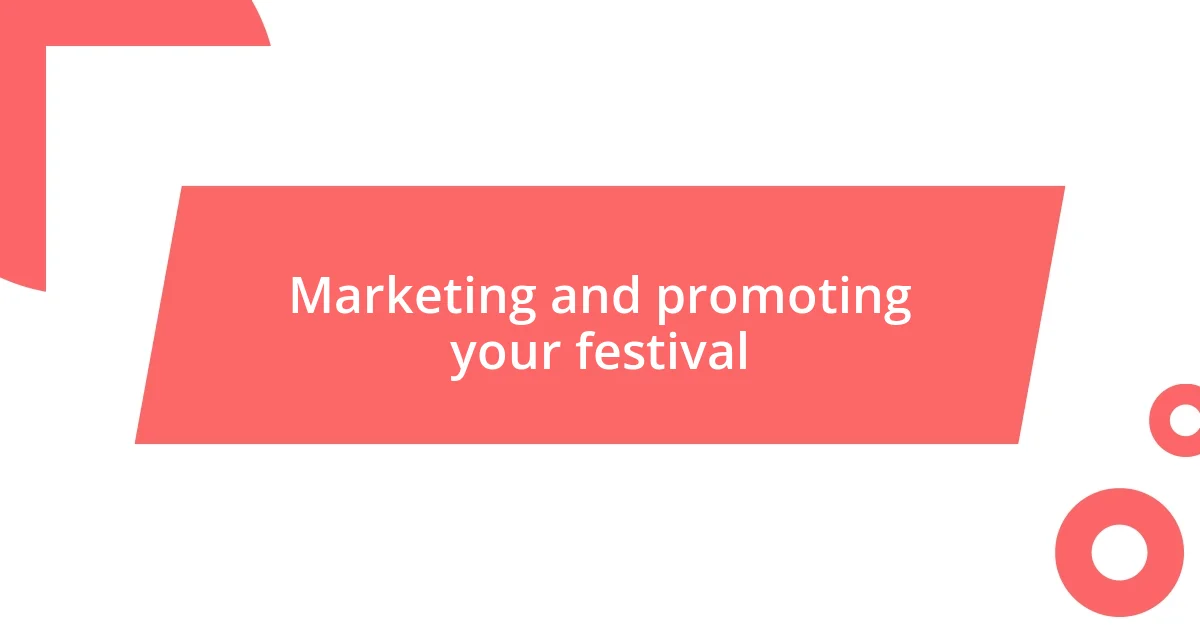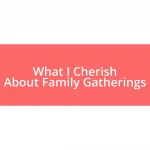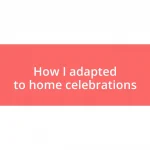Key takeaways:
- Defining a unique festival concept is essential and should reflect personal passions to create an immersive experience for attendees.
- Choosing the right venue enhances the festival vibe and supports logistical needs, contributing to a memorable atmosphere.
- Engaging in post-event evaluations, including attendee feedback, helps identify improvements and build community for future events.

Defining your festival concept
Defining your festival concept is a deeply personal journey that starts with what truly inspires you. For instance, when I was brainstorming ideas for my festival, I reflected on the music and art that resonated with me most, and it sparked a vision of combining different genres—something you don’t often see in traditional festivals. What draws you in? The more you dig into your passions, the sharper your concept will become.
I remember sitting down one late evening, surrounded by sketches and playlists, contemplating what atmosphere I wanted to create. Perhaps it was the wistful sounds of indie folktales that made my heart swell, blended with vibrant street art, that painted my vision. Creating a festival is not just about the logistics; it’s also about curating an experience that reflects who you are. What emotions do you want to evoke in your attendees?
As you flesh out your concept, consider the essence of your festival—its soul. I found that pinpointing a unique theme helped me connect with like-minded individuals and build a community. It’s not merely an event; it’s a gathering of shared experiences and passions. How will your vision translate into a memorable and meaningful event for those who share your interests?

Choosing the right venue
Choosing the right venue is crucial to the success of your festival. I learned that the location should not just accommodate your expected crowd, but also enhance the overall vibe you want to create. For my festival, I sought out a space that embodied a sense of magic and intimacy, and I found it in an old amphitheater cloaked in greenery. It was more than just a venue; it felt like a character in itself.
What struck me most during the venue-hunting process was how logistics can dramatically impact the festival experience. Availability of amenities like parking, restrooms, and accessibility can transform an attendee’s experience from frustrating to delightful. I remember the clarity I felt when I visited a potential venue that surprised me with its serene beauty and ease of access. It made me realize that a thoughtfully chosen venue could significantly contribute to the festival’s narrative.
Finally, consider how the chosen venue aligns with your festival’s concept. I opted for a rustic barn to convey a sense of nostalgia and warmth, which worked beautifully with my theme of community connection. The aesthetic of that space not only fit my vision but also resonated with the diverse group of artists and participants, creating an atmosphere filled with joy and comfort.
| Venue Types | Key Features |
|---|---|
| Amphitheater | Natural ambience, excellent acoustics |
| Barn | Rustic charm, intimate space |
| Civic Center | Accessibility, ample facilities |
| Parks | Open space, scenic beauty |

Curating talent and performers
Curating talent and performers is one of the most exhilarating parts of festival planning. I approached this process with a vision of diversity and authenticity in mind, ensuring that every artist I selected could genuinely resonate with my festival’s theme. I remember attending numerous underground gigs, absorbing the vibe of emerging talents that seemed to magically encapsulate the spirit I wanted for my festival. It was thrilling to discover artists who not only have incredible skills but also embody the emotions I wanted the attendees to feel, creating a powerful synergy.
When curating talent, it’s essential to consider a mix of both established names and hidden gems. This balance not only attracts a broader audience but also creates an exciting atmosphere where discovery thrives. Here’s how I went about it:
- Research Emerging Artists: I spent countless nights digging through Bandcamp and local music venues to find fresh talent.
- Connect with Other Curators: Collaborating with other festival organizers introduced me to a wealth of performers who I would have otherwise overlooked.
- Crowdsource Recommendations: I reached out to my social media followers, asking them to suggest their favorite local musicians, which not only engaged my audience but also helped me unearth brilliant acts.
- Attend Local Events: Immersing myself in the local music scene allowed me to witness firsthand the passion and energy of up-and-coming artists.
Each decision felt like a step toward crafting a vibrant tapestry of sound and experience, and it genuinely excited me to think about the connections these performers would create with the festival-goers.

Designing the festival experience
Designing the festival experience involves much more than just selecting artists and a venue; it’s about creating an immersive environment that leaves a lasting impression. I remember attending a festival once where the decor transformed the space into a whimsical wonderland, with twinkling lights and interactive art installations. It made me wonder—how could I evoke that same sense of enchantment in my own festival?
One key element I focused on was the sensory experience. I envisioned scent, sound, and sight blending harmoniously. For instance, I collaborated with local artisans to create unique food stalls that not only offered mouthwatering bites but also looked visually stunning. Each dish was designed to be Instagram-worthy, knowing how much people love to share their experiences online. It wasn’t just about hunger; it was about crafting moments that felt special.
Another vital aspect was the flow of the festival. I spent hours mapping out how attendees would move through the space. Would they stumble upon a surprise dance performance while wandering toward the main stage? Or perhaps a cozy nook for a quiet conversation? I took inspiration from my own experiences at festivals, recalling how certain layouts either enhanced or distracted from my enjoyment. The goal was to create pathways that encouraged exploration and serendipity, allowing each festival-goer to feel like an integral part of the unfolding story.

Marketing and promoting your festival
Marketing and promoting your festival demands a blend of creativity and strategy. I remember launching my festival with a social media campaign that sparked excitement among potential attendees. I asked myself, “What would make someone stop scrolling and pay attention?” I crafted visually captivating posts, using vibrant images and engaging captions that emphasized our unique vibe. This not only built anticipation but also fostered a community feeling before the big day.
Collaboration played a pivotal role in amplifying my festival’s reach. Partnering with local influencers and businesses helped me tap into their established audiences. I recall reaching out to a popular food blogger who had a genuine love for local events. By offering her tickets in exchange for a shout-out, I secured a whole new wave of interest. It’s such a simple yet effective tactic—leveraging the networks of others can extend your festival’s visibility far beyond your immediate circle.
In the end, I realized that word-of-mouth can be your most potent marketing tool. After the first day of the festival, I noticed attendees buzzing about their favorite moments, excitedly sharing experiences with friends on social media. Isn’t it fascinating how a single joyous encounter can lead to a ripple effect? I made sure to engage with these conversations online, responding warmly to comments and sharing user-generated content to keep the energy flowing. This approach not only amplified the festival’s reach but also created a sense of belonging among attendees, making them feel more connected to the experience.

Managing logistics and operations
Managing logistics and operations was one of the most intricate parts of curating my own festival. I remember feeling both excited and overwhelmed as I devised a master checklist detailing everything from securing permits to coordinating with vendors. Have you ever considered how even the smallest detail can impact the overall experience? For instance, I found that arranging for ample restroom facilities and food stations in strategic locations greatly minimized wait times, allowing everyone to maximize their enjoyment.
Communication was crucial throughout the planning process. I made it a point to establish clear channels with all team members, from stage crew to volunteers. I vividly recall a moment during setup when a last-minute change forced the team to adapt quickly. Instead of panic, we banded together, utilizing a group messaging app to keep everyone informed. How incredible is it to witness a team transform challenges into opportunities for collaboration? This unity not only ensured smooth operations but also fostered a sense of camaraderie that lasted throughout the festival.
Finally, I learned the importance of a detailed schedule on the event day. When the gates opened, anticipation filled the air, but behind the scenes, timing was everything. I had planned out everything meticulously—from sound checks to artist arrival times—ensuring that each component fit seamlessly into the festival’s flow. As I glanced at the crowd, their energy igniting the atmosphere, I couldn’t help but feel a twinge of pride. It was in those moments of organized chaos that I truly understood how careful planning could turn what seemed chaotic into something magical and memorable.

Evaluating festival success and feedback
Evaluating the success of my festival involved analyzing a mix of attendee feedback, ticket sales, and social media engagement. I remember painstakingly sifting through comments and surveys after the event, eager to gauge how well we resonated with our audience. Have you ever read feedback that made your heart swell with pride? Positive remarks about the festival’s atmosphere and seamless logistics validated all the hard work we had poured into the planning process.
However, not everything was sunshine and rainbows. I distinctly recall some comments about longer wait times for food, which was a painful realization. Instead of ignoring this criticism, I embraced it as an opportunity for growth. What could we change for next time? I quickly brainstormed potential solutions, like increasing vendor numbers and optimizing layouts to enhance the flow of traffic.
In the weeks following the festival, engaging with our audience on social media proved invaluable. I launched a post-event survey to collect insights directly from attendees. Their responses not only provided clarity but also demonstrated a community eager for our return. Asking them what they’d like to see next time inspired fresh ideas and made them feel involved. Isn’t it remarkable how feedback can transform into a roadmap for future success?















